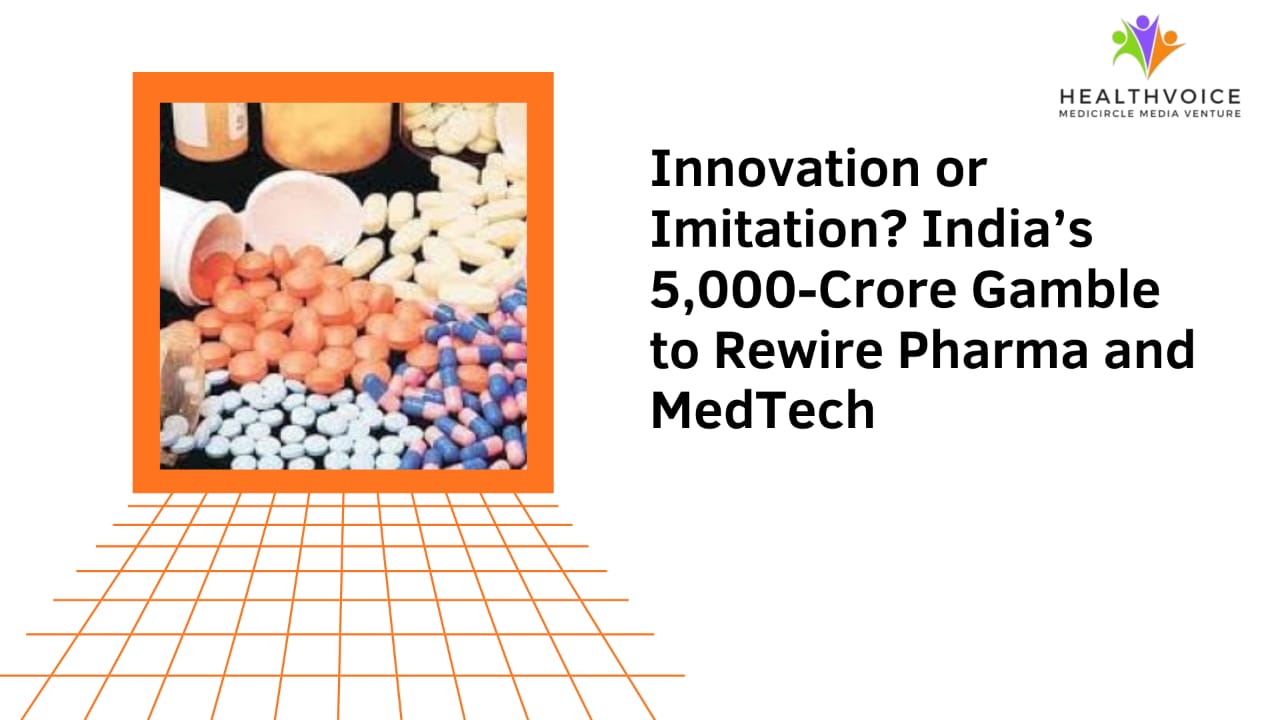Innovation or Imitation? India’s 5,000-Crore Gamble to Rewire Pharma and MedTech
Within weeks, the government is expected to formally launch the scheme, opening a new chapter in India’s healthcare journey.

The Indian pharmaceutical and medical technology sectors stand on the edge of transformation. The government’s ambitious Promotion of Research and Innovation in Pharma MedTech (PRIP) scheme, with an outlay of ₹5,000 crore, promises to change the way the country thinks about medicine, devices, and indigenous capacity. Announced in August 2023 and now nearing a formal launch, the scheme has raised hopes across industry corridors, policy circles, and among healthcare professionals who understand how deeply innovation is tied to the nation’s health security.
The government insists this is a bold leap forward. Amit Agrawal, Secretary of the Department of Pharmaceuticals, speaking at the APACMed event, outlined how the scheme is not a token incentive but a structural intervention to strengthen India’s research and development ecosystem. By offering both early-stage and late-stage support, the idea is to encourage startups, established firms, and research institutes to step beyond the safe path of generic production and incremental improvements, and instead focus on novel discoveries and breakthrough technologies. This marks a deliberate shift in vision from being the “pharmacy of the world” through mass production of affordable drugs, to positioning India as a genuine hub of pharmaceutical and medtech innovation.
The timing could not be more critical. Globally, healthcare is being redefined by advanced biologics, AI-driven diagnostics, digital therapeutics, and medical devices that merge engineering with data science. For decades, India’s medtech sector has been dominated by imports, with multinational corporations controlling the supply of advanced devices. Even today, stents, imaging machines, and implantable devices are mostly sourced from outside the country. While Indian companies have made strides in consumables and low-to-mid tech devices, the challenge has always been in scaling up manufacturing of complex, high-grade equipment. The PRIP scheme is designed to chip away at this dependency by building domestic capacity in critical components and raw materials, an area where India has remained vulnerable.
Policy insiders argue that this is not just about economics but about sovereignty. The COVID-19 pandemic revealed how fragile healthcare supply chains can be when countries close borders or prioritize their own populations. India’s vaccine story was one of triumph, but its struggles to import ventilators, testing kits, and high-end diagnostics in the early months exposed the cracks. The government does not want a repeat of that. By investing in indigenous innovation, India hopes to insulate itself from such crises while also positioning itself as a global supplier of both medicines and devices in the decades ahead.
Yet, for all the optimism, experts caution that innovation cannot be commanded by budgetary allocations alone. Research culture in India has long struggled under bureaucratic hurdles, lack of infrastructure, and limited risk appetite. Universities and research labs produce brilliant minds, but most migrate abroad for better opportunities. Industry often prefers the safer route of generics and contract manufacturing rather than betting big on long, expensive, and uncertain R&D pipelines. Will PRIP truly change these behaviours, or will it risk becoming yet another well-intentioned scheme that is poorly executed?
The allocation itself of ₹4,250 crore earmarked for R&D signals seriousness, but implementation is where the challenge lies. For innovators, time is as critical as money. Delays in approvals, absence of clear pathways for clinical trials, and the maze of compliance often push startups into survival mode. If PRIP does not address these systemic bottlenecks, funding alone may not translate into results. In fact, some argue that the scheme should be paired with deeper reforms in intellectual property policy, faster regulatory clearances, and incentives for academia-industry collaboration.
The medtech sector, in particular, deserves sharper focus. Unlike pharmaceuticals, which already have a global footprint through generics, medtech in India remains underdeveloped. Despite experiencing double-digit growth for over 15 years, most of the sector’s innovations are incremental and small-scale. Large multinationals continue to dominate the high-end device market, from MRI machines to robotic surgical systems. The government’s plan to establish three medical device parks by 2027 is a welcome step, as shared infrastructure can reduce costs for startups and smaller manufacturers. But the real question is whether these parks will simply assemble imported kits or truly become centres of cutting-edge innovation that design and manufacture products suited to India’s unique healthcare landscape.
Healthcare professionals, particularly doctors and hospital administrators, are watching this space with curiosity and caution. For them, innovation is not an abstract idea, it directly impacts how they diagnose, treat, and save lives. A cheaper, locally made stent or dialysis machine could expand access for patients who cannot afford imported devices. At the same time, poorly regulated innovations can put patients at risk. Doctors remember past controversies where devices of questionable quality flooded the market in the absence of stringent checks. Patient safety must remain at the heart of this innovation drive, for any lapse here could undermine public trust in the entire system.
Beyond ethics, there is a cultural aspect to address. For decades, the Indian pharmaceutical identity has been tied to being the world’s supplier of generics. This has given the industry scale, credibility, and export strength. Asking companies to now pivot to high-risk innovation requires a change in mindset as much as in infrastructure. Startups may embrace this, but established firms may hesitate. The PRIP scheme needs to build confidence through sustained support, predictable policies, and a clear roadmap that shows industry players that innovation is not a gamble but a viable long-term strategy.
Minister of State for Health Anupriya Patel has called the medtech sector a “sunrise sector,” a term that captures both its promise and its infancy. Indeed, the sector has barely scratched the surface of what is possible. Imagine diagnostic devices that work seamlessly in rural clinics without requiring constant electricity, or AI-powered tools that assist doctors in early cancer detection. Imagine drug delivery systems tailored for India’s disease burden rather than copied from Western markets. These are the kind of innovations that can redefine Indian healthcare and, if exported, transform global health as well.
But imagination must be matched by discipline. Transparency in how funds are allocated, accountability in measuring outcomes, and a feedback loop between government, industry, academia, and healthcare professionals will determine whether PRIP lives up to its promise. For doctors and healthcare providers, the stakes are high. They need tools that are safe, effective, and suited to their patients. For patients, innovation is not about fancy technology but about access, affordability, and survival.
Ultimately, the PRIP scheme is a statement of intent. It declares that India no longer wants to play only the role of a low-cost producer but aspires to lead in discovery and invention. Whether this ambition translates into reality depends on how thoughtfully the scheme is executed and how sincerely all stakeholders like government, industry, researchers, and healthcare professionals work together. The scheme’s success will not be measured by the crores spent, but by the lives improved, the diseases treated, and the confidence restored in India’s ability to not just manufacture medicine, but to create it.
For now, the countdown has begun. Within weeks, the government is expected to formally launch the scheme, opening a new chapter in India’s healthcare journey. The world will be watching to see if this is a turning point or just another policy announcement in a long list of unfinished promises. For doctors, researchers, and patients alike, the hope is that it is the former, because the future of Indian healthcare cannot be built on imitation. It must be rooted in innovation.
 Sunny Parayan
Sunny Parayan
#healthvoice #PharmaInnovation #MedTechIndia #FutureOfHealthcare #DigitalHealth #MakeInIndia #HealthcareInnovation #MedicalDevices #PharmaResearch #IndianHealthcare #HealthTech #AtmanirbharBharat
